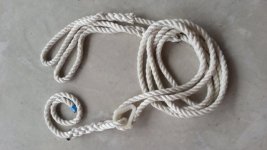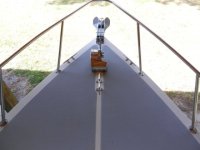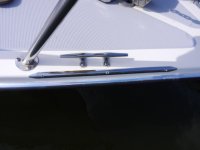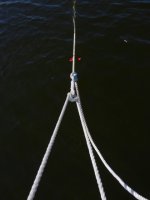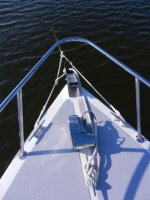jhspear
New member
- Joined
- Sep 10, 2013
- Messages
- 15
- Reaction score
- 0
- C Dory Year
- 2008
- C Dory Model
- 22 Cruiser
- Hull Identification Number
- CD022682D708
- Vessel Name
- Obsession
On the advice of several members I added a winch to my (new to me) C-Dory 22. One of the issues, however, is the lack of a fair lead from the anchor roller to the cleat because of the width of the windlass. The windlass is a Maxwell HRC-6 Horizontal.
I am hesitant to tie off the rode at the bow cleat and allow the rode to lead over the windlass to the bow. This would put considerable downward pressure on the winch as well as the deck.
One system I have read about several times involves a separate bow line which consists of a heavy line attached directly to the bow eye. the free end of the bow line is clipped to the pulpit when not in use but to anchor one ties off the rode to a ring at the end of the bow line. As a back up the rode would still be tied off to the bow cleat but there would be slack in the line at this point.
There are some advantages to this system in that the attachment point is considerably lower than the deck cleat and thus a shorter scope is needed for anchoring. The disadvantage of course is greater complexity.
But my main concern is the strength of the bow eye. Or is this not a concern with C-Dory's? The "feats of strength" of this boat are legendary, but do they extend to the bow eye?
Or maybe there are alternate methods of cleating off.
Thanks.
I am hesitant to tie off the rode at the bow cleat and allow the rode to lead over the windlass to the bow. This would put considerable downward pressure on the winch as well as the deck.
One system I have read about several times involves a separate bow line which consists of a heavy line attached directly to the bow eye. the free end of the bow line is clipped to the pulpit when not in use but to anchor one ties off the rode to a ring at the end of the bow line. As a back up the rode would still be tied off to the bow cleat but there would be slack in the line at this point.
There are some advantages to this system in that the attachment point is considerably lower than the deck cleat and thus a shorter scope is needed for anchoring. The disadvantage of course is greater complexity.
But my main concern is the strength of the bow eye. Or is this not a concern with C-Dory's? The "feats of strength" of this boat are legendary, but do they extend to the bow eye?
Or maybe there are alternate methods of cleating off.
Thanks.

